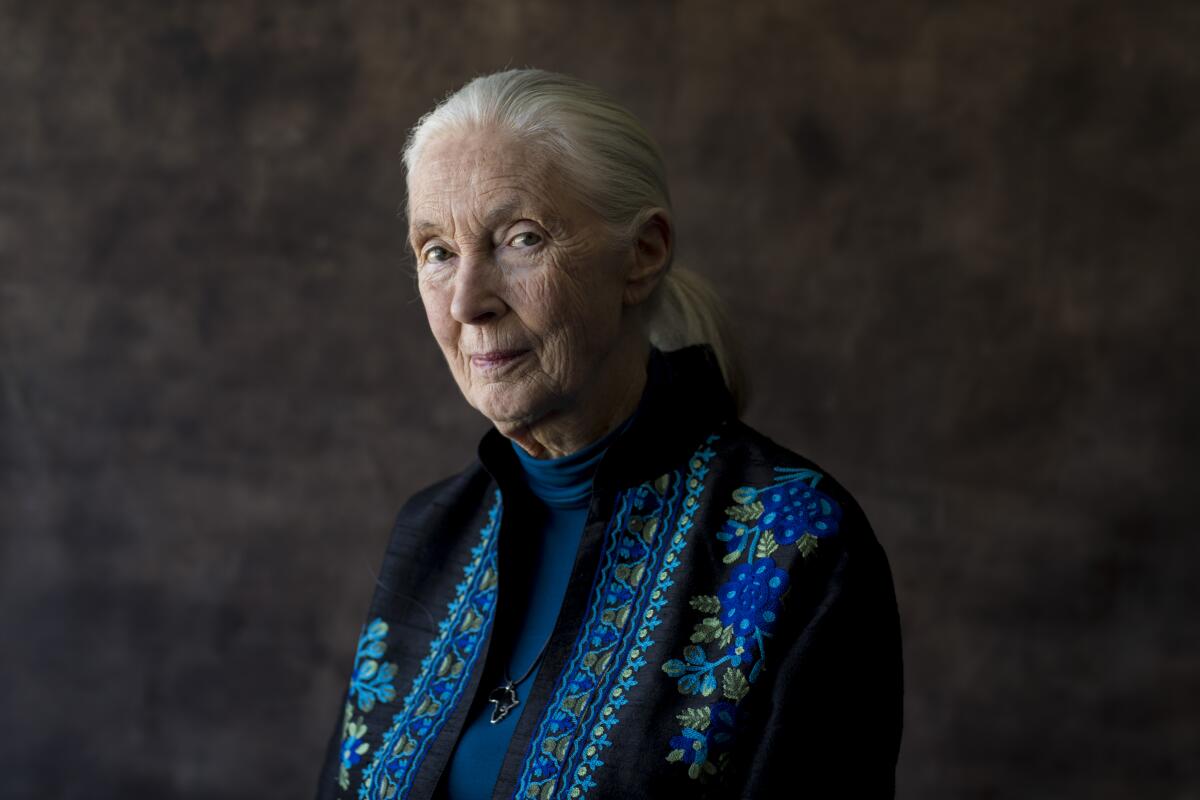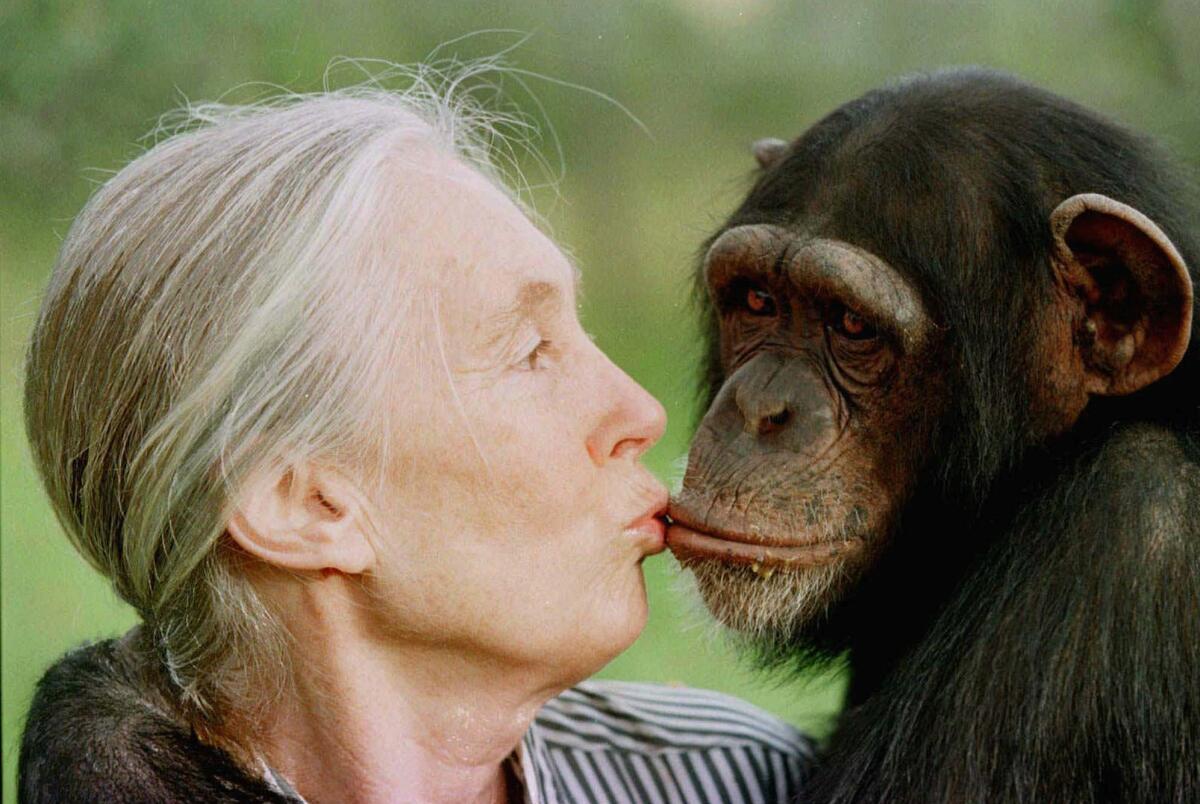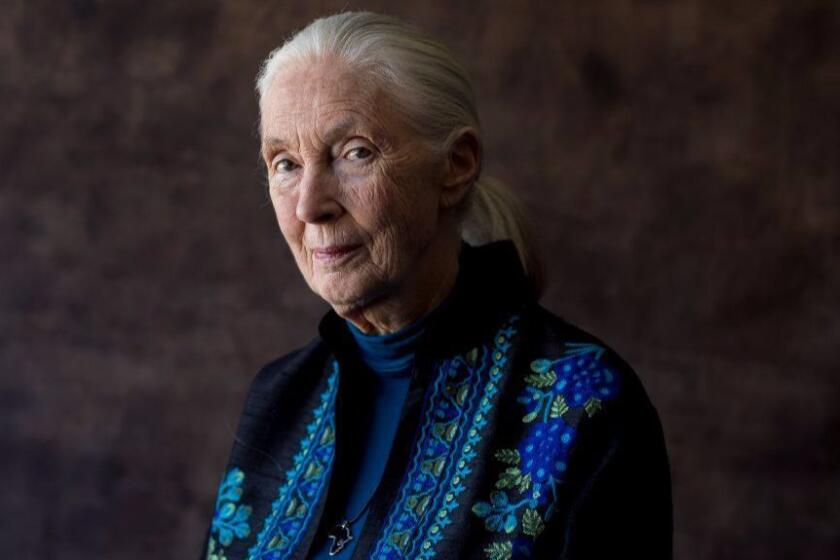Jane Goodall, a pioneering naturalist famous for her close-up studies of chimpanzees in Africa, has passed away. Her detailed observations greatly changed how we understand humans and our place in the world. She was 91 years old.
Jane Goodall, a dedicated champion for protecting chimpanzees’ homes, passed away on Wednesday morning in California due to natural causes, according to a post on the Jane Goodall Institute’s Instagram page.
According to a statement from the Jane Goodall Institute, Dr. Goodall’s work as an ethologist fundamentally changed the field of science.
Jane Goodall, mentored by anthropologist Louis S.B. Leakey, achieved a groundbreaking discovery in 1960. She found that chimpanzees – our closest animal relatives – created and used tools. This was significant because scientists previously believed tool use was unique to humans.
She additionally discovered that chimpanzees hunted for food, consumed meat, and demonstrated a wide spectrum of feelings and actions comparable to humans, such as affection for their young, sadness, and aggression that sometimes resembled organized conflict. She observed that they were capable of complex social interactions and exhibited behaviors mirroring human emotional responses, including love for their offspring, experiencing grief, and displaying violent tendencies akin to warfare.

While creating one of the longest studies ever done on wild animal behavior at what is now Gombe Stream National Park in Tanzania, she chose to give the chimpanzees she studied names instead of numbers. This was unusual in the 1960s, when most primate research was done by men and relied on numerical identification. However, within ten years, the neat and precise British scientist, known for her tidy ponytail, became famous through National Geographic. Her books and films shared the stories of the apes she knew as David Graybeard, Mr. McGregor, Gilka, and Flo, reaching a global audience and changing how people understood these animals.
The late biologist Stephen Jay Gould described how, when people first learned about Jane Goodall – a woman who playfully named chimpanzees and then carefully observed their behaviors in the wild, documenting even their smallest sounds and interactions – the scientific community was hesitant to consider her work truly significant. He wrote, “When we read about a woman who gives funny names to chimpanzees and then follows them into the bush, meticulously recording their every grunt and groom, we are reluctant to admit such activity into the big leagues.”
Despite facing criticism, Goodall ultimately proved her detractors wrong and created work that Gould would later describe as “one of the Western world’s great scientific achievements.”
Driven and with a sharp eye for detail, Goodall opened doors for other women in the study of primates, like the late gorilla researcher Dian Fossey and orangutan expert Birutė Galdikas. In 1995, she received the National Geographic Society’s Hubbard Medal, an honor that had only been given 31 times in the prior 90 years to well-known figures such as North Pole explorer Robert E. Peary and pilot Charles Lindbergh.
Even into her 80s, she maintained a rigorous travel schedule, speaking for around 300 days a year. Her message focused on the importance of stopping deforestation, protecting the homes of chimpanzees, and encouraging environmentally friendly growth in Africa. She was traveling in California for a speaking engagement across the U.S. when she passed away.
Books
Jane Goodall brings “The Book of Hope” to the Los Angeles Times Book Club Feb. 25.
Jane Goodall was born on April 3, 1934, in London and spent her childhood in the coastal town of Bournemouth, England. Her parents, a businessman and a writer, separated and eventually divorced when she was young. She was raised by the women in her family – her maternal grandmother, mother (Vanne), aunts, and sister, Judy – creating a strong matriarchal household.
From childhood, she had a strong love for the natural world. She used to collect worms and sea snails in her room, but quickly returned them outside when her mother explained they wouldn’t survive indoors. This showed her early compassion and understanding of their needs.
I remember my mom telling me this story about when she was a little girl, around 5 years old. She completely vanished for hours, and the family was going crazy looking for her! Turns out, she’d snuck off to the dark henhouse, totally fascinated by how chickens laid eggs. She was so absorbed in watching them, she didn’t even notice everyone was worried sick! She wouldn’t budge from her little observation post until she’d finally witnessed the amazing moment. It’s a sweet story about her early curiosity, and how she’d get completely lost in whatever she was studying. It just shows how much she always loved to learn – even if it meant causing a bit of a panic!
As if dropped, the egg fell onto the straw. The hen expressed her happiness with joyful clucks, shaking her feathers, gently touching the egg with her beak, and then walking away,” Goodall recalled nearly 60 years later. “I can still vividly remember everything that happened,” she noted.

Lifestyle
Growing up, Miguel Ordeñana was fascinated by wild animals. He found inspiration in Jane Goodall, and her work profoundly influenced his life’s path.
When she excitedly burst out of the henhouse with the news, her mother didn’t reprimand her. Instead, she carefully listened to her daughter describe her very first scientific observation.
Afterward, she gifted Goodall books focusing on animals and exciting stories-particularly the Doctor Dolittle series and Tarzan. Her daughter was so captivated by the world of Tarzan that she even demanded to do her schoolwork while sitting in a tree.
In her 1999 memoir, Reason for Hope: A Spiritual Journey, Goodall wrote that she was deeply in love with Tarzan, the Lord of the Jungle, and felt very jealous of his Jane. She explained that fantasizing about a life in the forest with Tarzan fueled her strong desire to travel to Africa, live among animals, and eventually write books about them.
Her chance to pursue her dreams arrived after graduating from high school. Just before Christmas in 1956, she received an invitation to visit the family farm of a childhood friend in Kenya. Jane Goodall carefully saved the money she earned working as a waitress until she had enough to buy a round-trip ticket.

She came to Kenya in 1957, excited to finally be living in the Africa she’d always felt a connection to. Soon after arriving in Nairobi, at a dinner party, she learned that if she wanted to learn more about animals, she should meet Leakey, who was already well-known for finding the fossils of early humans in East Africa.
She visited him at the location that is now the National Museum of Kenya, where he worked as the curator. He employed her as a secretary, and before long, she was assisting him and his wife, Mary, in their fossil excavations at Olduvai Gorge – a well-known archaeological site located on the Serengeti Plains in present-day northern Tanzania.
Leakey told her he was eager to study all the great apes in greater detail. He mentioned a group of chimpanzees living on the rough, eastern coast of Lake Tanganyika, suggesting that a brave researcher could potentially find important new information there.
Upon hearing that this was precisely the work she had always hoped for, Leakey consented to send her to the location. Goodall shared her lifelong dream, and he readily agreed.
It took Leakey two years to secure funding, allowing Goodall to study primate behavior and anatomy in London during that time. She eventually arrived in Gombe in the summer of 1960.
At a rocky spot she named the Peak, Goodall had her first key discovery. Previously, scientists believed chimpanzees were gentle creatures who only ate plants. However, around three months after she began her research, Goodall watched a group of chimps eating something pink. She soon realized it was a baby bush pig.
Two weeks passed, and she made an even more thrilling discovery – the one that would truly make her famous. She’d started to learn the individual personalities of the chimpanzees, and on a rainy day in October 1960, she noticed a chimp with white hair on his chin. He was sitting next to a pile of reddish dirt, carefully inserting a piece of grass into a hole, then pulling it out and putting it in his mouth.
After he slowly walked away, Goodall quickly went to investigate. She picked up the piece of grass he’d left behind, put it back into the hole, and pulled it out. It was covered in termites! The chimpanzee she would later call David Graybeard had been using the grass like a tool to catch the insects.
“I found it difficult to process what I had witnessed,” Jane Goodall later explained. “For a long time, people believed that humans were the only animals on earth capable of using and creating tools. We were known as ‘Man the Toolmaker’…” Goodall’s observations questioned the idea that humans were special in this way.
After receiving her report, Leakey replied with a startling statement: “We need to rethink what it means to be human, reconsider our definition of a tool, or acknowledge that chimpanzees are, in fact, human!”
Jane Goodall’s groundbreaking discovery, which appeared in Nature in 1964, helped Leakey secure funding to continue supporting her research at Gombe. This also made it easier for Goodall to be accepted into Cambridge University to study animal behavior (ethology). In 1965, she made history as only the eighth person at Cambridge to receive a doctorate without first completing a bachelor’s degree.
While continuing her work, she met Hugo Van Lawick, a talented filmmaker, in 1964. He had come to Gombe to film a documentary about her chimpanzee research, and they later married. They had a son, Hugo Eric Louis, who would later be known as Grub, in 1967.
Goodall explained that caring for Grub, who resided at Gombe until the age of 9, deepened her understanding of how chimpanzee mothers behave. She also stated she was certain that watching the chimpanzees made her a better mother herself.

Movies
“So,” Brett Morgen began, “you’ve been telling your story for so many years.
I was so fascinated by her life! She and Van Lawick were together for a decade, but sadly they divorced in 1974. Then, the following year, she found love again with Derek Bryceson, who was the director of Tanzania National Parks. It was heartbreaking to learn that he passed away from colon cancer just four years later.
Within a year of starting her work at Gombe, Jane Goodall had chimpanzees confidently taking food directly from her hands. Near the end of her second year, David Graybeard – the chimpanzee who seemed least afraid of her – became the first to let her touch him. She gently touched him, and he surprisingly allowed her to groom him for a whole minute before softly moving her hand away. As she wrote in her 1971 book, “In the Shadow of Man,” this acceptance of physical touch from a human by a wild-born adult male chimpanzee was “a Christmas gift to treasure.” It was a truly remarkable moment.
Her research revealed a wealth of insights into chimpanzee behaviors, including social customs – like how they would ask for a pat on their rear to show they were yielding – and their mating habits. She gathered particularly interesting details about the latter by observing Flo, an older female with a distinctive bulbous nose and a large number of admirers, who continued to have offspring into her 40s.
At first, her findings were met with doubt from many scientists. She remembered a 2012 interview with CBS, saying, “A lot of scientists didn’t take me seriously. They saw me as a National Geographic cover model,”.
Her unique way of treating the chimpanzees as individuals sparked significant debate. The editor of one of her early published studies initially demanded that all pronouns like “he” or “she” be replaced with “it” when referring to the animals. However, Goodall ultimately convinced the editor to allow more personalized language.
Her most unsettling research occurred in the mid-1970s, as she and her team started documenting a number of brutal assaults.
The events escalated into what Jane Goodall termed the four-year war, a time of extreme violence committed by a group of male chimpanzees from the Kasakela Valley. These chimpanzees attacked and killed all the adult males in a nearby group, and then took control of the females, effectively wiping out the entire community. They beat and slashed the males to death and subjugated the females.
This marked the first instance of a scientist observing coordinated, hostile behavior between two groups of non-human primates. Goodall described this “nightmare time” as a pivotal moment that fundamentally altered her understanding of ape behavior.
In her 1999 book, “Reason for Hope: A Spiritual Journey,” co-authored with Phillip Berman, she wrote that for the first decade of her research, she thought Gombe chimpanzees were generally kinder than people. However, she then discovered that chimpanzees could also be incredibly cruel – revealing, like humans, that they too had a darker nature.
Some reviewers attempted to downplay the findings as just based on personal stories. Others believed she shouldn’t have shared details of the violent behavior, worried that some scientists might misuse the data to claim war is simply built into human nature, inherited from our primate relatives. Despite these concerns, Goodall continued to discuss the attacks, emphasizing that she wasn’t trying to either support or disprove ideas about human aggression, but rather to gain a better understanding of why chimpanzees behave aggressively. She wanted to understand chimpanzee aggression itself.
I asked: How much progress have chimpanzees made on their own evolutionary journey, considering where our own path has taken us – to a place of hatred, wrongdoing, and widespread war?
Jane Goodall’s studies of aggression in chimpanzees dramatically changed how scientists viewed primates. Previously, it was generally avoided to describe chimpanzee behavior using human-like terms. However, by the 1980s, researchers were increasingly interpreting chimp actions in ways that would have been considered anthropomorphism-attributing human characteristics to animals-just a few decades before. By breaking down these barriers, Goodall significantly advanced the field of primatology, paving the way for studies of diverse topics, from political alliances among baboons to the use of deception in various primate species.
World & Nation
Chimp change
Driven by her deep commitment to safeguarding chimpanzees both in their natural habitats and in zoos, she created the Jane Goodall Institute in 1977. This organization works to champion great apes and fund vital research and educational initiatives. Additionally, she founded Roots & Shoots, a program empowering young people in 130 countries, and TACARE, which partners with African communities to promote environmentally friendly and sustainable development.
In 1986, after watching a film showing how chimpanzees were mistreated in labs, she began working internationally to protect chimps and promote conservation. She described the hidden camera footage as being similar to “looking into the Holocaust,” as she told Cathleen Rountree in 1998. This experience transformed her into a tireless advocate for animal rights, traveling the world to champion their cause. She became a global leader in the fight for better treatment of animals.
The 2017 documentary Jane was created using 140 hours of previously unseen footage of Jane Goodall, which the producer discovered in the National Geographic archives. The film was highly acclaimed, earning a Los Angeles Film Critics Assn. Award among other honors.
During a wide-ranging 2009 interview with Times columnist Patt Morrison, Goodall shared her thoughts on various subjects. She stated that most zoos, as they currently exist, should be closed, and expressed deep concern about climate change, believing humanity was rapidly losing-or had already lost-the fight against it. She also discussed the significant impact a single person can have.
I often tell people that taking even a small amount of time to consider how your daily decisions impact the world – things like what you purchase, consume, wear, and how you treat others, including animals – and then deliberately choosing options that are helpful instead of damaging, would be a really positive step.
Over time, Goodall kept observing the chimpanzees of Gombe, gathering a wealth of information that revealed the full story of their lives-from birth, through often difficult teenage years, adulthood, sickness, and eventually, death.
She powerfully described following Mr. McGregor, an older chimp who was a bit grumpy, as he sadly passed away from polio. She also wrote about Gilka, an orphan who lived to adulthood but then tragically had her babies taken by two chimps who ate other chimps’ young.

Jane Goodall’s response in 1972 to the death of Flo, a very successful female chimpanzee and considered Gombe’s most dedicated mother, showed how deeply Goodall cared for the animals. She knew that Flo’s son, Flint, was close by and was also grieving, so Goodall stayed with Flo’s body all night. She did this to protect it from being disturbed by wild bush pigs.
“I’m often told ‘thank you for creating such memorable characters and giving them unique personalities,’” CBS’s “60 Minutes” reports Goodall once said. “But I always reply that I didn’t *create* anything. I simply interpreted what was already there and shared it with others.”
Woo is a former Times staff writer.
Read More
- Clash Royale Best Boss Bandit Champion decks
- Brawl Stars December 2025 Brawl Talk: Two New Brawlers, Buffie, Vault, New Skins, Game Modes, and more
- Best Hero Card Decks in Clash Royale
- Clash Royale December 2025: Events, Challenges, Tournaments, and Rewards
- Call of Duty Mobile: DMZ Recon Guide: Overview, How to Play, Progression, and more
- Best Arena 9 Decks in Clast Royale
- Clash Royale Witch Evolution best decks guide
- All Boss Weaknesses in Elden Ring Nightreign
- Brawl Stars December 2025 Brawl Talk: Two New Brawlers, Buffie, Vault, New Skins, Game Modes, and more
- Deneme Bonusu Veren Siteler – En Gvenilir Bahis Siteleri 2025.4338
2025-10-01 21:34
